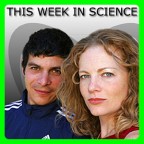Podcast: Play in new window | Download (Duration: 1:10:45 — 32.4MB)
Space Madness, Clicking Plants, Sensitive Birds, Counting Bears, LHC Excitement, Drones Against Poaching, TWIWRD, Ancient Cowherds, And Much More…
Disclaimer, Disclaimer, Disclaimer!!!
This Week in Science… coming up next
Space madness!!!
A big step for China
China has sent its first expedition to a space station, including their first woman astronaut in space. The station should be complete by 2020 and is set to weigh around 60 metric tons. This might be a reason for the US to get back in the space race!
Shackleton’s Ice Mystery
A crater’s surface on the moon’s south pole could be made up of as much as 22% ice! Lasers detected parts of the crater to be far brighter than the rest of the moon’s surface, at wavelengths consistent with what you would expect from ice. Maybe Newt’s moon colony is closer than we thought!
Sounds of the universe
Dark matter, baryonic matter, and light interacted at the origin of the universe to make the universe itself very lumpy and clumpy, according to new simulations. Uh oh. Nobody likes lumps in their universe…
Plants can talk to each other by clicking!
We know that plants respond to sound, but new research suggests that plants can also communicate with each other with clicking sounds that emanate form their roots. Corn saplings have been shown to produce clicking sounds from their roots at around 200 Hz, and grew towards the clicking when it was reproduced in a water suspension. What will we discover that plants can do next?!
Birds don’t like noise
A baby songbird tends to learn the songs that are the most clear, and therefore the easiest to pick up on. It’s no surprise then, that birds can be influenced in which songs they learn, and therefore which they sing, by noise pollution. Sparrows in noisy areas near human populations have a shorter songbook that those in nature, and we humans are therefore creating fragments in sparrow culture. This takes animal dialects to a whole new level!
Blair’s Animal Corner!
Counting Bears, you say?
Three captive black bears recently performed amazingly well on touch screen number-based tests at Oakland University. This is the first touch screen based study with large carnivores, and scientists were impressed by the bears’ ability to recognize the relative size of clusters of dots. The bears were able to pick the larger or smaller group of dots, depending on which they were trained to identify, even when the size of the area the dots were in varied, indicating that they bears were doing something analogous to counting.
Get a free audiobook at Audible.com!
LHC UPDATE!!!
Scientists have discovered something that “looks like a Higgs is supposed to look.” What’s more, the Large Hadron Collider has already collected a huge amount of data that could further indicate a Higgs boson, it just needs examining. Fingers crossed, people!
Nepal launches drones to reduce poaching:
Conservationists in Nepal have recently developed drone aircrafts to monitor populations of endangered species for poaching activity. They successfully piloted two “unmanned” conservation drones in Chitwan National Park earlier this mont. The drones are equipped with GPS and a camera, and the WWF hopes to use them to guard Indian Rhinos and Tigers, for starters. Now if only we could fit them with lasers…
World robot Domination!!! –
Robots get touchy feely
A new specially designed robot can detect different natural materials according to their textures. This appendage has a soft malleable texture over a liquid filled center, much like a real finger, and in fact performed better than humans at identifying things by touch. This could pave the way for prosthesis or even commercial enhancement, or lead to sensitive robots that could take over the world!!!
Humanoids milked cows 7,000 years ago in Saharan Africa!
Fatty acid analysis of some pottery excavated in Libya indicates that dairy fat was present. This is astonishing due to the fact that it is the first instance of milk use found in Africa, and perhaps helps us to connect the dots as to when our ancestors gained the enzyme that allows us to process lactose.
If you love TWIS, please support us by donating below:



14:20 I wouldn’t have thought to use sound.
You seem to have misunderstood. They did not “use sound” in this simulation!
Baryon Acoustic Oscillations (BAO) are not literally sound waves.
Sound is a thing that happens to atoms, we’re talking about a time before atoms.
BAO are waves that include a longitudinal component, analogous to sound waves.
That is what Matthew Francis, the author of the article, was getting at. Poorly.
Towards understanding plant bioacoustics
I wager the roots are growing in response to some uncontrolled variable, not sound.
For example, the magnetic field from the speaker, as opposed to the sound waves themselves.
Speakers use more power at low frequencies (<200 Hz) than at high-frequencies (>200 Hz).
Is it just a coincidence that Gagliano et al measured best response around 200 Hz?
I suspect not, but since I can’t read the fulltext article, so my skepticism is measured.
Can someone who has read the article share how variables like magnetic fields were controlled?
Also, what range of frequencies were tested?
http://www.sciencedirect.com/science/article/pii/S1360138512000544
http://en.wikipedia.org/wiki/Audio_power#Power_handling_in_.27active.27_speakers
42:20 [Higgs] Boson Party!
22:30 That will be a day of celebration.
Not for Justin! He hates the Higgs. He’ll probably cry.
Hi TWiSsers! (TWiSlers?)
Just to clear up a confusion you seemed to have regarding sigma and p-values. In Biology, a p-value of 5% is considered “significant”, meaning that there is only a 1-in-20 chance that the data would have been generated by a random process. Physics is a *lot* more strict about the level of evidence they demand. In fact, a p-value of 5% only corresponds to a 2 sigma event (meaning 2 standard deviations from the mean).
In physics, you typically need 3 sigma to say there is “evidence” that the observed effect is real – anything below that isn’t even worth mentioning. That would correspond to a p-value of 0.3%! That is the level that the LHC achieved last year.
A 4-sigma event would be a chance of one in 16,000, or a p-value of 0.006%. The gold standard to call something a “discovery” in physics is typically 5 sigma, or a chance of less than 1 in 1.7 million that the data would have been generated by a random event. 6 sigma would be about a 1 in half a billion chance.
How do you feel about your puny 5% p-values in Biology now?
28:33 They’ve found counting abilities in primates before, but never in any other type of animal.
The authors of the article list many non-primate animals that have been shown to use “quantity estimation” or “numerousness judgement” such as dolphins, elephants, birds, fish and amphibians. For example, the authors reference the work with Alex, the African Grey Parrot, who appears to have been able to understand numbers in a similar way as to chimpanzees or young children.
Sorry to nitpick, I enjoyed the show.